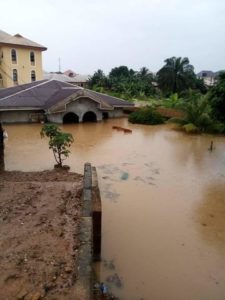
When it began to rain about 5am on Sunday, July 7, 2019, Daniel Asuquo, a native of Uruan Local Government Area may have thought of the pleasures the cold weather holds while in the warm cuddle of his dear wife.
He never envisaged that in less than two hours, the torrential downpour will instead of delectation cause him a deleterious experience where his household properties, market wares will all be destroyed leaving him distraught and traumatized. No thanks to the ravaging flood which accompanied the rainfall barely two hours after it streamed down from the pregnant cloud.
Asuquo resides at Mbiabong Ikot Essien along Shelter Afrique Extension, Uyo. According to him, the flood took over the area with his compound not spared and in the process destroying household items, market wares which he got on hired purchase. Asuquo who noticed that the flood level had almost reached his waist discerned the risk it may pose on his children hence had to cross them over to another area for safety.
Residents of Mbiaobong Ikot Essien are not the only ones suffering from the July 7th flood in Uyo. Residents of Mbiaobong Ikot Udowut, Udo Ekot Street, Akpasak Estate, Nung Ete, Mobil Housing Estate near Shelter Afrique, Ewet Housing extension behind PDP, IBB Avenue among other areas are seriously devastated by the flood.

Things have fallen apart and life no longer at ease for hundreds of residents of these areas. They have been subjected to all manners of suffering by the marauding floods. Some victims in these environment are planning to relocate to homes of friends at locations considered safe hence enable them reorganize themselves, evaluate loses and possibly come out of the trauma. Notwithstanding, is this flood yet another unforseen occurrence that may have escaped the predictive eyes of the authorities? What has the State government done about this? What really is the cause of flooding in Uyo and how can it be addressed? These are the some of the questions that may be plaguing your mind.

Prediction Ahead of the Flooding
On April 30, 2019, the Nigeria Hydrological Services Agency (NIHSA) which is under the Federal Ministry of Water Resources issued a report on 2019 probable flood scenarios across the country.
In the report, it mentioned Akwa Ibom State among the 30 states in Nigeria which would experience severe flooding in June, July, August and September. The agency attributed the predicted flooding to climate change and other man-made factors, including the dumping of refuse in drains and building of structures on natural water channels. NIHSA charged States to be proactive in addressing the man-made causes hence limit the effect of the flooding. Yet, now that the prediction has manifested unprecedentedly in Uyo among the 31 local government areas in the State, What has the State government done to alleviate the condition of her people?
Government’s Effort
The State Emergency Management Agency ( SEMA) , an agency tasked with the responsibility to give relief to disaster victims say they are aware of the situation and have activated machineries to ensure the victims of the flood receive relief.
According to the Permanent Secretary, Deputy Governor’s Office, Akwa Ibom State, Mr Nkopuruk Ekaiko who heads SEMA, 611 flood victims who were assessed last year and early this year have benefited from financial assistance in June, last month. He assures that after assessment of the current situation, the flood victims will be given aid.
Devoid of plans to give relief, are there concrete efforts or plans to either stop or reduce flood in Uyo? Efforts to speak with the Immediate Past Commissioner for Environment and Solid Minerals and Commissioner Designate, Dr Iniobong Essien did not yield result as he neither answered phone calls directed to his known phone line nor reply text messages as at Press time. Yet, are the relieve effort of government really enough to address this problem?
According to Policy Alert, in a Press Statement signed by the Organization’s Director, Tijah Bolton, the Akwa Ibom State Government among governments of other coastal States cannot claim to be taken unawares given the terrible experience of flooding last year coupled with repeated warning by Nigerian Meteorological Agency, NiMet.
Policy Alert notes ” It is just a failure to plan. Most of the affected areas are always affected, year in, year out. There is only but little government response about the situation. Disaster preparedness levels are very poor and State governments are not budgeting nearly enough for this issue. This has to change if we must make progress “. Nevertheless, why has Uyo really been seriously affected by the flood, you may wonder.
Severe Flooding in Uyo: The Reasons
According to I. J. Ekpoh, an Environmental expert from the Department of Geography and Natural Resources Management, University of Uyo, Uyo, the peculiar reason for severe flooding in Uyo is because of modernization and
urban renewal efforts which comes with difficulties, especially with regard to drainage reconstruction. He explains that these urban features, together
with the characteristic terrain feature of an imperceptibly gently-rolling-landscape, shallow and inadequate surface drains, as well as, the
poor attitude of some residents towards waste disposal, have combined to make the city vulnerable to flash flooding whenever it rains.
He posits ” With over 90 percent of the
land area of Uyo Capital city being gently rolling or flat, the terrain constitutes a serious hindrance to the evacuation of runoff through surface drains. Thus, topography plays a very significant role in making the problem of flooding in Uyo intractable because water has little or nowhere to run to, whenever it rains.”
He explains that in many
places within the State Capital, the surface drains or gutters simply serve as mere ditches for runoff to accumulate rather than channels for evacuating runoff, due to the absence of slope.
The environment expert points out that some of the gutters were constructed during pre-state creation era when Uyo was just an administrative headquarter with few urban structures hence they are currently unable to withstand the 21st Century climate change-induced rainfall of recent past and present.
Ekpoh offers insight to the fact that since Uyo became a state capital in 1987, massive urbanization has not helped matters either, as previously green areas and marginal lands have been seriously encroached upon. He explains that Surface drainage systems which could check flooding in Uyo do not work due to constraints posed by topography and urbanization. “Topography affects surface drainage through the absence of slope while massive and, at times, uncontrolled urbanization constitutes serious obstacle to drainage path,” he asserts.
Ekpoh however points out that climate change as a recent phenomenon, has added an unexpected dimension to an already precarious situation of recurrent flooding in Uyo, by bringing more rainfall to coastal and immediate hinterland
towns in Nigeria.
He adds ” This has caused serious
distortions to the hydro-climatic regime of the study area. Climatic predictions
from General Circulation Models (GCMs) for Nigeria suggest that climate change will affect the country through sea level rise along its coastline as well as alterations in the local climate which may witness more extreme rainfall in the south (leading to severe cases of flooding, erosion and mass wasting) and intensified aridity in the north (causing incessant droughts and desertification). These projections are consistent with current, real-time weather observations in Nigeria.”
In addition to the major factors that are
responsible for flood problems in Uyo, Ekpoh says the habit of disposing wastes into gutters and drains, which he mentions is common among residents of the capital city is inimical to effective flood-water evacuation, as the wastes would normally block and glug the gutters, leading to overflow of water from the gutters into streets and homes. He further adds that unauthorized urban structures also obstruct natural water-ways, leading to flooding. Following the numerous causative reasons for following in Uyo, is there any way these problems can be addressed?
Way forward to address flooding in Uyo
Environment Experts identify “Pipe Jacking” flood control system as the key to solving flood problems in Uyo.
Pipe jacking is a technique for installing
underground pipelines, ducts and culverts to evacuate storm waters. Already, the system which has gulped billions of naira from the State coffers has been implemented in parts of Uyo capital city.
Areas noticed to enjoy swift evacuation of flood-waters owing to the provision of pipe jacking system are the environs of Itam and Udo Udoma Avenue.
Ekpoh says the reason Pipe Jacking system stands as the major solution to the flood problem is because it has the ability to overcome the problem of flat terrain with absence of slope.
He adds “Although the pipe-jacking system may be expensive, it is a worthwhile effort as it is efficient not only in evacuating runoff through underground tunneling, but also causes minor
disruption to the city’s infrastructure and
facilities as opposed to open drains.
“Moreover, since pipe-jacking is an underground drainage system, it is also capable of eliminating the problem of silting and wastes disposal into open gutters by the residents.”
The expert however notes that making provision for pipe jacking system is not enough. He recommends that stiff
penalties should be meted out to culprits who dispose refuse in gutters coupled with more green areas created within the city to encourage infiltration of rain water and through-flow.
He opines that in order to decongest the present urban crowdedness, new investments and structures should be taken to the urban peripheries of Uyo, as was done with the Ibom Hotels and Golf resort in Nwanaiba while structures and facilities that are located on natural drainage channels should be relocated.
Ekpoh maintains that since climate change stands as a major factor in the recent flood episodes in Uyo, responding to climate change from both policy level and house-hold level is required.
What is more, the expert states that since past emergency response systems have proven to be inefficient, It would be appropriate if there is a provision for a robust, efficient system of response that would cater not only for the relief materials needed by the people, but also provide the strategy for tackling the underlying causes of the problem through the creation of a systematic framework of doing things.
He adds ” A proper strategy for combating those floods would not only focus on the provision of relief materials, but will also consider the drainage system in terms of apparent need for de-silting of gutters, possible expansion of existing gutters and the construction of new ones (including pipe- jacking) where necessary, so as to prepare for the containment of future storm-water runoff.
” Tackling climate change should be
everyone’s business and not left for government alone. our actions today will determine the environment we have tomorrow. By choosing to take appropriate action today, we limit the damage for tomorrow. Failure to do so may result in environmental catastrophe of monumental proportion. In the words of Francis Bacon – He that will not apply
new remedies, must expect new evils, for time is greatest innovator”.




